Easter Island is a relatively small island (163,6 km²), in the South Pacific aproximately 3700 kms away from mainland South America and as such one of the most isolated places on Earth. The triangular form of the island is largely formed by 3 volcanoes. The Rano Kau and Terevaka, Poike volcanoes. Sandy beaches are only found on the North Coast; along the coastline you will mainly find cliffs, caves and foothills of the volcanoes as they reach the ocean.
What the island is world famous for, are the colossal stone statues known as Moai, which stand on rectangular Ahu, ceremonial platforms. Overall, there are more than 16,000 archaeological sites on the island. Easter Island, or Rapa Nui, has probably been colonized somewhere in the 6th or 7th century by Polynesians, who have lived in seclusion from the rest of the world, and thus achieved a remarkable original, authentic culture.
Easter Island was discovered by, by westerners on the 1st Day of Easter in 1722, by Dutch explorer Jacob Roggeveen, who called it Easter Island. In 1888, the Chileans annexed the Polynesian island, politically aligning it with the Valparaiso province of Chile. The inhabitants of Easter Island have different names for their country: Rapa Nui: great Rapa, big rock; To pipo o to henau: the navel of the world; Mata ki rani: eyes that look to heaven, which probably refers to the to the eye sockets of the Moai statues that tilted towards the sky.
The entire island has been on the World Heritge UNESCO listings.
.
Our 5 Easter Island Regions:
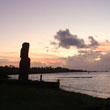 Hanga Roa:
Hanga Roa:
Can’t you wait either to spot your first Moai? Right in the centre of the capitol Hanga Roa, you can stand face to face with these massive statues. If you continue a little further on to the North, there are some more to look at.
.
.
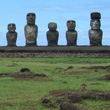 South:
South:
On the South Coast there is one of the biggest and most impressive monuments of the island: Ahu Tongariki, as well as the place where the Moai were quarried from the volcano mountainside of the Rano Raraku.
.
.
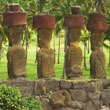 North:
North:
On the North shore of the island you can experience both the positive energy of nature, as well as relex on a paradise white sandy beach, where 7 Moai with ‘tatoos’ on their backs greet you.
.
.
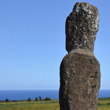 West:
West:
Where the countryside is irregular due to eriosion, and lava flows, is where you can enter dark dark caves with impressives views of the ocean. And a little further on more landinwards, you find the only 7 Moai that look out over the sea.
.
.
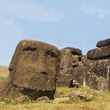 South West: On the mountain side of the Rano Kau vulkaan you can find the ceremonial village Orongo, with the surrounding ingraved rocks. Until 1888 this was the starting point of swimming match in sharck infested waters, where competitors need to swim to the island Moto Nui, to fetch the first egg of a Stern.
South West: On the mountain side of the Rano Kau vulkaan you can find the ceremonial village Orongo, with the surrounding ingraved rocks. Until 1888 this was the starting point of swimming match in sharck infested waters, where competitors need to swim to the island Moto Nui, to fetch the first egg of a Stern.
.

